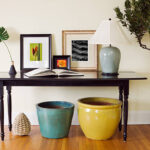Designing your home can be fun yet overwhelming. Changing colors and furniture arrangements will easily come to mind if you want to refresh your space. However, these are more in line with interior design and may dampen your enthusiasm if you don’t know where to start.
The good thing is that the art of interior design now goes beyond traditional means. More than colors and furniture, you can create esthetically functional spaces using other elements. One of these is indoor gardening.
Using houseplants as interior decorations isn’t new. Statista’s latest data show that the leading future trends for interior design are natural elements or biomaterials. As a result, many now use houseplants to make spaces naturally aesthetic.
The process can be intimidating if you are a beginner at interior design and indoor gardening. Do not worry because we’re here to help. Keep reading to learn how to design your home with houseplants.
Why use houseplants as indoor decorations?
Houseplants are natural and eco-friendly decorations to bring nature into your home. They can create warmth, unearth your decorating style, and liven up narrow corners. Additionally, you can easily swap them whenever you want to refresh your rooms.
Houseplants are not only used as decorations to beautify spaces. They are also purposeful greeneries that offer plenty of benefits. These include enhanced productivity, improved mood, air cleaning, and reduced stress levels. You may also have easy access to food ingredients, as you can use some for cooking, like basil and oregano.
Since many houseplants are low-maintenance, you do not have to worry about their care. Many of them can thrive in low-light conditions, making them ideal indoors. However, while it seems easy to take care of them, you still need to learn about indoor gardening, especially if you are a beginner.
Tips for interior decorating using houseplants
Like any other interior design technique, incorporating houseplants as home decorations takes time. You cannot just grab a plant and put them in areas you like. It can be daunting and time-consuming, but manageable.
Here are tips on how to interior decorate using houseplants:
- Think about your desired theme
Before you find houseplants to use, consider the themes you like. You can go for vines and lush greenery or herbs and flower. You should choose the one that matches your personality the most.
Unleash your creative juices and add fun twists to your green interior design based on your liking. This step is necessary to kickstart your interior design goals.
Sketching gives you a clear picture of your theme. It can also help you remember the interior design details you like. Get some blank papers and colored pens, and start bringing your green interior design to life. At this point, start preparing your budget as well.
- Research houseplants you like
Professional gardening is hard work. Experienced gardeners do not merely grab plants to care for and call it a day. They dedicate their time to studying them for the best growth results.
You are not using houseplant decorations just for them to rot and die. Take time and research the houseplants you want to use based on existing indoor space conditions. Proper knowledge about the houseplants you like will help your indoor plant care succeed.
Aside from considering indoor plant care, pick houseplants that match your style. That way, you will not be lost when it is time to purchase them.
- Purchase from reliable plant stores
When you are done researching, it is time to buy your chosen houseplants. You can get them from nearby garden stores when you can physically shop. Garden caretakers can also give you real-time advice on how to take care of your bought houseplants.
Online plant shops are also available if you cannot go out to shop. Many offer a wide variety of houseplants with affordable discounts. They can even deliver houseplants to your doorstep.
How to use houseplants in decorating your home
Now that you have your houseplants, it is time to arrange. Even with a sketch, arrangements can be confusing when considering last-minute changes. Here are ways to help you set your houseplants for the best aesthetics:
- Lighten dark areas with low-light houseplants
You can repurpose your home’s dark areas into something beautiful. Many houseplants can grow in low lights, so take the chance to make these corners alive. Some examples of low-light plants are ZZ plants, parlor palms, pothos, calathea, and Chinese evergreens.
- Mix and match houseplants of all sizes
Do not hesitate to think outside the box for your green interior design. Take it to the next level and create a contrast by mixing and matching houseplants of different shades and sizes. You can follow the interior design “rule of three,” where you arrange various houseplants in odd numbers.
The rule of three does not mean you can only use three houseplants. You can also use five, seven, or nine as long as they are odd numbers.
- Make a statement with indoor trees
When you are finally used to small houseplants, you can level up the game. Start using oversized floor-standing indoor trees to set focal points in vital areas of your home. You can make a statement by using them in your living room, kitchen, entryway, or bedroom.
If you do not like to use an already big houseplant, you can have ones that can grow bigger instead. They will eventually grow to fit your intended space and make it lively.
Keep it natural with houseplants
Houseplants are great additions to your home décor. They can level up your interior design and style your spaces effortlessly. While they can be aesthetic materials to beautify your home, they are still living things. They also need proper care to grow and thrive.
This is where indoor gardening comes into the picture. You cannot incorporate houseplant décors without knowing even the basics. Although some houseplants may be low maintenance, you should take care of them accordingly. They care for you by providing plenty of benefits, so you should do the same.
Note that some houseplants may be poisonous, so store them correctly and out of reach of pets and children.







